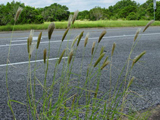Native Plants

Q. Who is Mr. Smarty Plants?
A: There are those who suspect Wildflower Center volunteers are the culpable and capable culprits. Yet, others think staff members play some, albeit small, role. You can torture us with your plant questions, but we will never reveal the Green Guru's secret identity.
Did you know you can access the Native Plant Information Network with your web-enabled smartphone?
Ask Mr. Smarty Plants is a free service provided by the staff and volunteers at the Lady Bird Johnson Wildflower Center.

rate this answer
Thursday - May 16, 2013
From: Lake Jackson, TX
Region: Southwest
Topic: Non-Natives, Grasses or Grass-like
Title: Native alternative to Japanese grass from Lake Jackson TX
Answered by: Barbara Medford
QUESTION:
Is there a native alternative to Little Kitten maiden grass? I was asked to comment on a plan and don't want them to introduce another Japanese plant into our local habitat.ANSWER:
Before we could answer your question we first had to determine what the non-native grass is to which you refer. Turns out it is Miscanthus sinensis 'Little Kitten' which is, indeed, native to eastern Asia. It is a member of the Poaceae (grass) family, and is referred to as a "blooming grass." What it is not, as you have already pointed out, is native to South Texas, in the area of Brazoria County.
Since the Lady Bird Johnson Wildflower Center, home of Mr. Smarty Plants, is committed to the growth, propagation and protection of plants native not only to North America but to the area in which those plants grow naturally, we are anxious to find some natives for you to propose as alternatives. These are all members of the Poaceae family and grow in or near Brazoria County. You can follow each plant link to our webpage on that plant to learn its expected mature size, growing conditions, water needs, preferred soil, etc. Since they are native to your area, they are much more likely to do well in your climate, soils and rainfall than grasses from Asia.
Chloris virgata (Feather fingergrass) - 0 - 1 ft. tall
Heteropogon contortus (Tanglehead) - 0 - 1 ft. tall
Andropogon gerardii (Big bluestem) - 3 to 6 ft. tall
Schizachyrium scoparium (Little bluestem) - 3 to 6 ft. tall
From the Image Gallery
More Grasses or Grass-like Questions
Lawn for a Shady & Wet area in Austin, TX
July 22, 2015 - We have a drainage area that has appeared in our back yard since the neighbors’ homes were built. When we get heavy rains (like this year) all their drainage flows into our back yard and forms a river...
view the full question and answer
Erosion control on partially shaded slope
November 27, 2010 - Mr. Smarty Plants,
I live in Atlanta, GA. My house is on a hill, and I am beginning to have erosion at my backyard porch (concrete slab, on the corners especially). The soil is mainly red clay, a...
view the full question and answer
Native grasses for organic farm in Elgin TX
July 22, 2014 - Hi there, I am working to restore native grasses on our certified organic farm in Elgin, TX. We raise eggs, grass fed beef, and grass fed lamb.
I am having a terrible time finding organic pastur...
view the full question and answer
Plants for creek bank in North Carolina
April 29, 2011 - I would like a list of plant options to plant on an almost vertical creek bank in some location in Charlotte, NC. The creek runs through a 300 acre basin, maybe 3 or 4' high banks and I have never se...
view the full question and answer
Problems with Habiturf in Austin
May 10, 2014 - I have been trying to establish a Habiturf lawn in my back yard. It is approximately a 1,000 square foot area and this last seeding was the third over about one and a half years. I just recently over ...
view the full question and answer
| Support the Wildflower Center by Donating Online or Becoming a Member today. |

